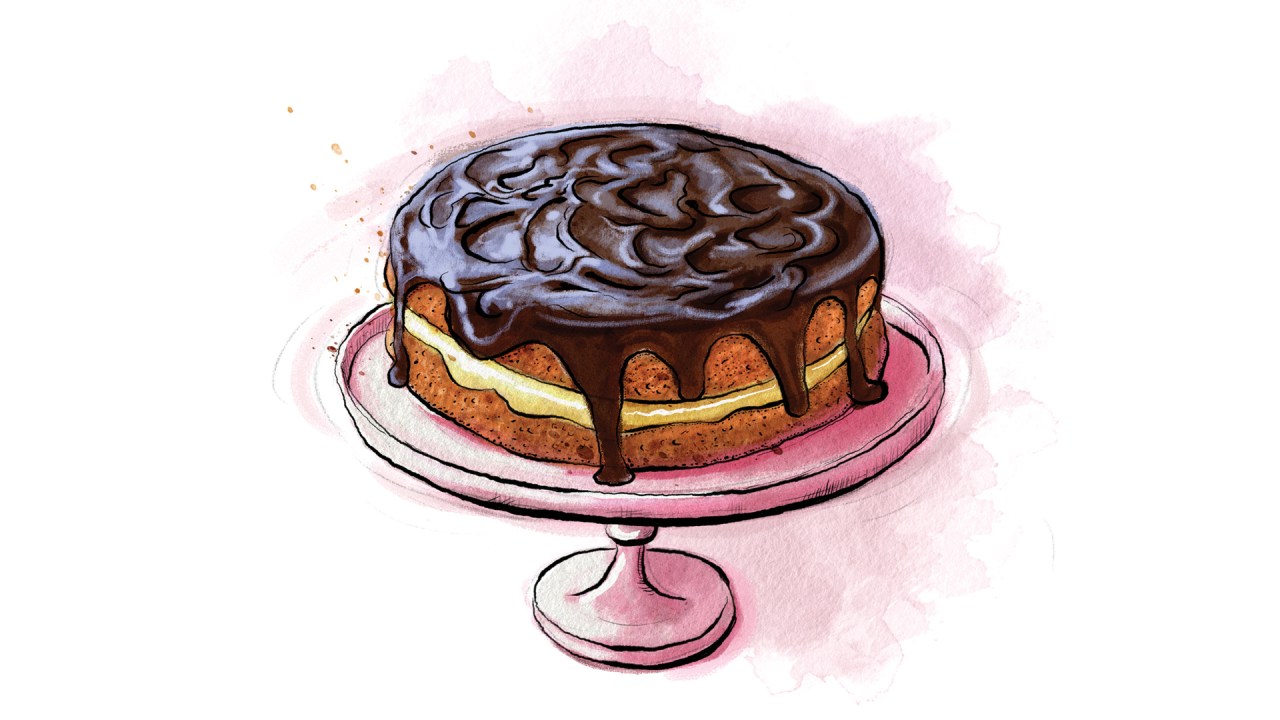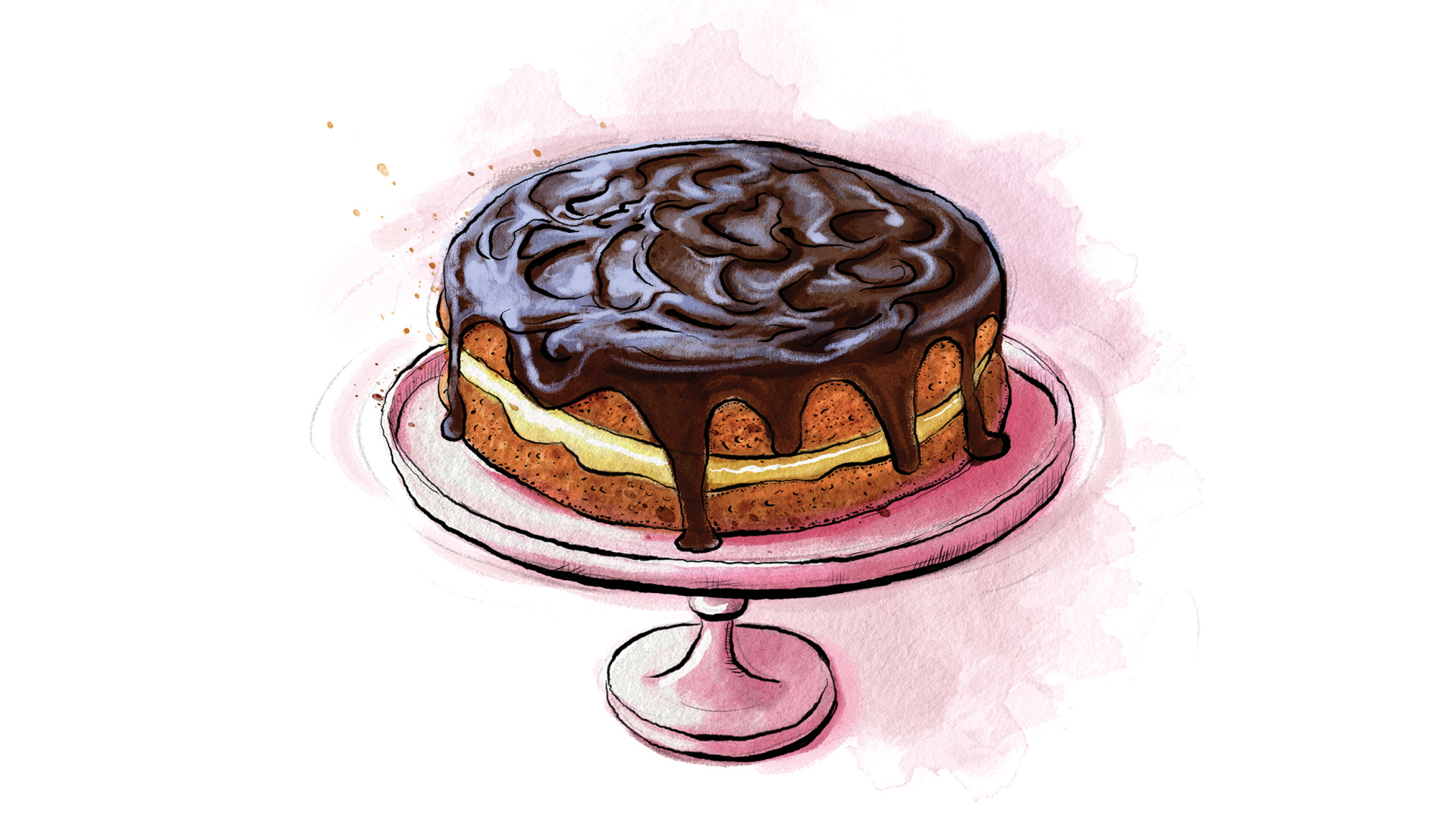They say you can’t teach an old dog new tricks, but perhaps you can teach it old tricks. When I embarked on making a Boston cream pie, I thought I knew it all when it came to sponge cakes. I’d creamed butter and sugar, using elbow grease and a wooden spoon or employing the horsepower of a stand mixer’s whisk attachment. I’ve used the all-in-one-method; I’ve melted butter and folded it into cake batters in the pursuit of sticky denseness. And I’ve folded in egg whites, holding my breath in an attempt not to knock any air out of the mix.
But I had never made a Boston cream pie, and so I had never made a hot milk sponge. Could this old dog learn something new?
The heat of the milk restricts the gluten development, and results in a remarkably tender sponge
The first thing to say about Boston cream pie is that it is neither a pie and nor is it filled with cream. It is, definitively, a cake, made up of two vanilla sponges, with a thick custard filling, and then covered in a glossy chocolate ganache that drips down the sides. When the cake was first made in the 19th century, the same baking tins would be used interchangeably for pies and cakes, and therefore the names of the puddings would too. When it came to Boston cream pie, the pie moniker stuck.
There is at least some geographical plausibility in the name. The Parker House hotel, a long-established hotel in Boston, takes credit for its invention, dating it to 1856. The hotel certainly has heritage: it gave the US its beloved Parker House rolls, the soft, buttery dinner rolls traditionally served at Thanksgiving, and counted both Ho Chi Minh and Malcolm X among its staff at various points (Ho Chi Minh worked there as a pastry chef – did he ever make the Boston cream pie?).
What probably made the pie stand out was its chocolate topping: chocolate was not a habitual component of puddings in Boston in the mid-19th century, where it was more usually consumed as a drink.
The cake quickly became a mainstay of the hotel, but it didn’t become a popular domestic bake until the 1930s. Before that, the Boston cream pie would have been made with a more delicate genoise sponge base, but the hot milk sponge had become a favourite of the American housewife, and it was soon adopted for the Boston cream pie.
A hot milk sponge is what it says on the tin: the sponge begins straightforwardly, with eggs and sugar whisked together until increased in volume, before flour and baking powder are folded in. But then hot – nearly boiling – milk and melted butter are added at the last moment to the batter. The heat of the milk restricts the gluten development, which results in a remarkably tender but robust sponge, full of flavour.
The first time I made a hot milk sponge, I worried that pouring the near-boiling milk into my egg mixture would cause the whole thing to collapse, but how wrong I was. Removing the cakes from the oven, I was an immediate convert. I had never produced such tall, proud, straight-sided cakes, without a hint of a dome. And they didn’t sink, but stayed perfectly, gloriously level.
There are a couple of things to be aware of when you’re baking the sponges, which may seem counter-intuitive if you’re a practised baker: don’t line or grease the sides of the tin, as you want the cake to cling to the sides to allow it to rise to its fullest extent. Overbaking will result in the sponge pulling away from the sides, and shrinking at the top edge, so err on the side of caution when it comes to removing it from the oven.
Hot milk sponges have enough sturdiness to support the absurd amount of vanilla-specked pastry cream required for a Boston cream pie. The chocolate ganache is a simple one, dark, glossy and thick enough to stay on the top of the cake, just beginning to dribble down the sides; a not-too-sweet counterpoint to the otherwise mellow and vanilla-laden cake. The contrast between the bright blond sponge with pale custard and the dark chocolate dripping down the sides is a simple but beautiful thing.
For the cream
- 400ml whole milk
- 30g butter
- 1 tsp vanilla paste
- 35g cornflour
- 4 egg yolks
- ¼ tsp salt
- 130g sugar
For the sponge
- 100g plain flour
- 1 tsp baking powder
- 3 large eggs plus 2 large egg yolks
- 1 tsp vanilla paste
- 150g caster sugar
- 60ml whole milk
- 30g unsalted butter
For the chocolate topping
- 100ml double cream
- 1 tbsp golden syrup
- 100g dark chocolate, finely chopped
- Heat the milk in a pan with the butter and vanilla, until it is just coming to the boil, then remove from the heat. Whisk the egg yolks and sugar together, then whisk in the cornflour and salt.
- Whisk a little of the hot milk into the egg mix, and then continue adding the rest of the hot milk, whisking thoroughly. Return it to the pan and heat, stirring continuously, until the mixture comes to a boil and you see thick bubbles forming. Decant into a bowl, cover with clingfilm which touches the surface of the custard, and leave to cool.
- Preheat the oven to 180°C/160°C fan and line the bases of two ungreased 8in cake tins. Whisk the eggs with the sugar and vanilla until very pale and thick.
- Fold in the flour and baking powder. Quickly heat the milk and butter together until the butter melts and the mixture is very hot. Pour this into the cake batter, and fold through. Divide between the two cake tins, and bake for 25 minutes, until the sponge is risen and golden. Let the tins sit for a bit, then ease the cakes away from the sides, turn them out and leave to cool on a rack.
- To fill the sponges, vigorously whisk the pastry cream until it is silky. Spoon into the centre of one sponge, and place the other on top. Squish the whole very gently, so the cream reaches the edges; you can smooth the edge with a knife.
- Place the chopped chocolate in a bowl. Heat the cream with the golden syrup until it begins to simmer, then pour over the chocolate. After a couple of minutes, stir gently, working outwards. Once all is melted together, set aside to cool for 15 minutes. Then spoon the chocolate over the top of the cake, letting it creep down the edges. Leave to cool and set.
Sign up for Olivia Potts’s bimonthly newsletter, which brings together the best of The Spectator’s food and drink writing, here.








Comments